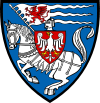Koszalin
| Koszalin | |||
|
|
|||
|
|||
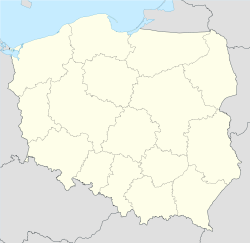 Koszalin
|
|||
| Coordinates: | |||
| Country | |||
|---|---|---|---|
| Voivodeship | West Pomeranian | ||
| County | city county | ||
| Established | 11th century | ||
| Town rights | 1266 | ||
| Government | |||
| - Mayor | Mirosław Mikietyński | ||
| Area | |||
| - Total | 84 km² (32.4 sq mi) | ||
| Elevation | 32 m (105 ft) | ||
| Population (2006) | |||
| - Total | 107,783 | ||
| - Density | 1,283.1/km² (3,323.3/sq mi) | ||
| Time zone | CET (UTC+1) | ||
| - Summer (DST) | CEST (UTC+2) | ||
| Postal code | 75-900, 75-902, 75-007, 75-016 | ||
| Area code(s) | +48 94 | ||
| Car plates | ZK | ||
| Website: http://www.koszalin.pl | |||
Koszalin [kɔˈʂalʲin] (![]() listen) (German: Köslin [kœˈslin]; Kashubian: Kòszalëno; Latin: Scurgum) is the largest city of Middle Pomerania in north-western Poland. It is located 15 km south of the Baltic Sea coast. Koszalin is also a county-status city and capital of Koszalin County of West Pomeranian Voivodeship since 1999. Previously, it was a capital of Koszalin Voivodeship (1950-1998).
listen) (German: Köslin [kœˈslin]; Kashubian: Kòszalëno; Latin: Scurgum) is the largest city of Middle Pomerania in north-western Poland. It is located 15 km south of the Baltic Sea coast. Koszalin is also a county-status city and capital of Koszalin County of West Pomeranian Voivodeship since 1999. Previously, it was a capital of Koszalin Voivodeship (1950-1998).
Contents |
History
In 1214 Bogislaw II, duke of Pomerania made a donation of a village known as Koszalice/Cossalitz by Chełmska Hill in Kołobrzeg Land (una villa ... Cussalitz iuxta Cholin in terra Cholbergensis) to the Premonstratensian (Norbertine) monastery in Białoboki (Belbuck) near Trzebiatów (Treptow an der Rega). New, mostly German, settlers from outside of Pomerania were invited to settle the territory. In 1248 the eastern part of Kołobrzeg Land, including the village, was transferred by Duke Barnim I to the Roman Catholic Diocese of Kammin.
On 23 May 1266, Bishop Hermann von Gleichen granted a charter to the village Cussalin, giving it Lübeck law, local government, autonomy and multiple privileges; it became known in German as Cöslin. In the following years Cöslin became the bishop's main residence and the capital of the Bishopric of Kammin.
By the acquisition of the village of Jamno (1331), part of Lake Jamno, a spit between the lake and sea and the stronghold of Nest (Unieście) (1353), Cöslin obtained direct access to the sea, participating in the next centuries in the Baltic Sea trade, which led to several conflicts with the competing seaports of Kolberg (Kołobrzeg) and Rügenwalde (Darłowo). From 1356 until 1417/1422, the Hanseatic city was part of the Duchy of Pomerania-Wolgast.
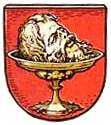
In 1534 during the Protestant Reformation, Cöslin became Lutheran under the influence of Johannes Bugenhagen. After the 1637 death of the last Pomeranian duke, Bogislaw XIV, Cöslin passed to his cousin, Bishop Ernst Bogislaw von Croÿ of Kammin. Occupied by Swedish troops during the Thirty Years' War, the city was granted to Brandenburg-Prussia after the Treaty of Westphalia in 1648. In these years it was considered to be the capital of the Duchy of Cassubia and later divided into Koszalin County, Kołobrzeg County, Bialogard County and Szczecinek County.
Part of the Kingdom of Prussia since its foundation in 1701, Cöslin was heavily damaged by a fire in 1718, but was rebuilt in the following years. It was occupied by French troops in 1807 after the War of the Fourth Coalition. Following the Napoleonic wars, the city became the capital of Fürstenthum District and Regierungsbezirk Cöslin within the province of Pomerania. The Fürstenthum District was dissolved on 1 September 1872 and replaced with the Cöslin District on December 13.
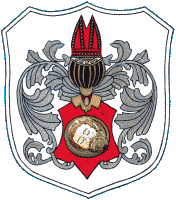
Cöslin became part of the German Empire in 1871 during the unification of Germany. The railroad from Stettin (Szczecin) through Cöslin and Stolp (Słupsk) to Danzig (Gdańsk) was constructed from 1858-78. A military cadet school created by Frederick the Great in 1776 was moved from Kulm (Chełmno) to Cöslin in 1890. In the 1920s during the Weimar Republic, the city's name was changed from Cöslin to Köslin. The city was detached from Köslin District on 1 April 1923, becoming an urban district.
During the Second World War Köslin was the site of the first school for the rocket troops created on orders of Walter Dornberger, the Wehrmacht's head of the V-2 design and development program.[1]
On 4 March 1945, Köslin was conquered by the Soviet Union during World War II. According to the post-war Potsdam Agreement, the city was placed under Polish administration and renamed Koszalin. Most of the German population fled or were expelled to post-war Germany. The city was resettled by Poles forming part of postwar repatriation of Poles (1944–1946) as well as the forced deportations from Polish lands annexed by the Soviet Union in the east. In addition, ethnic Poles of Kashubian descent as well as the Polish-Ukrainian, Lithuanian and Belarusian settlers arrived from various parts of prewar Poland.
Initially, the city was considered to become the capital of the newly created West Pomeranian Voivodeship, which nevertheless was assigned to Szczecin. In 1950 this voivodeship was divided into Szczecin Voivodeship and Koszalin Voivodeship.
In years 1950-75 Koszalin was the capital of the enlarged Koszalin Voivodeship sometimes called Middle Pomerania (out of 17 voivodeships total) due to becoming the fastest growing city in Poland. In years 1975-98 it was the capital of the smaller Koszalin Voivodeship (out of 49 total).
As a result of the Local Government Reorganization Act (1998) Koszalin was assigned to become part of the West Pomeranian Voivodeship (effective 1 January 1999) regardless of an earlier proposal for a new Middle Pomeranian Voivodeship covering approximately the area of former Koszalin Voivodeship (1950-75).
Landmarks
The city borders on Chełmska hill, a site of pagan worship in prehistory, and upon which is now built the tower "sanctuary of the covenant", which was consecrated by Pope John Paul II in 1991, and is currently a pilgrimage site.
Koszalin's most distinctive landmark is St. Mary's cathedral (Marienkirche), dating from the early 14th century. Positioned in front of the cathedral is a monument commemorating John Paul II's visit to the city.
Historical population
| Historical population of Koszalin | |||||||||||||
|---|---|---|---|---|---|---|---|---|---|---|---|---|---|
| Year | 1905 | 1939 | 1945[2] | 1950 | 1960[3] | 1970 | 1975 | 1980 | 1990 | 1999 | 2002 | 2003 | 2006 |
| Population | 21,474 | 33,500 | 17,000 | 18,900 | 44,400 | 65,200 | 77,600 | 93,500 | 108,700 | 112,375 | 108,480 | 107,877 | 106,125 |
Politics
Koszalin constituency
Members of Parliament (Sejm) elected from Koszalin constituency
- Bogdan Błaszczyk, SLD-UP
- Andrzej Lepper, chairman of Samoobrona, vice-prime minister of Poland
- Jan Łączny, Samoobrona
- Małgorzata Rohde, PO
- Ryszard Tomczyk, SLD-UP
- Bogusława Towalewska, SLD-UP
- Ryszard Ulicki, SLD-UP
- Zofia Wilczyńska, SLD-UP
- Edward Wojtalik, SLD-UP
Education
- Koszalin University of Technology (Politechnika Koszalińska)
- Baltic High School
Sports
- AZS Koszalin - men's basketball team, 7th in Dominet Bank Ekstraliga in 2007/2008 season.
- AZS Politechnika Koszalin - women's handball team playing in Polish Ekstraklasa Women's Handball League: 3rd place in 1st league in 2003/2004 season; promoted to Premiership in 2004/2005 season.
Major corporations
- Zakład Energetyczny Koszalin SA
- Brok SA
- JAAN Nordglass Autoglass
People
- Ewald Christian von Kleist (1715-1759), poet and officer
- Rudolf Clausius (1822-1888), physicist
- Paul Dahlke (1904-1984), actor
- Mirosław Okoński (born 1958), footballer
- Kuba Wojewódzki (born 1963), journalist and showman
- Beata Pawlikowska (born 1965), traveler, writer, journalist
- Mirosław Trzeciak (born 1968), footballer, director of sport development of Legia Warszawa
- Sebastian Mila (born 1982), footballer
Twin towns
 Neubrandenburg
Neubrandenburg Neumünster
Neumünster Berlin
Berlin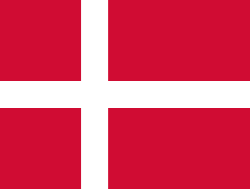 Gladsaxe
Gladsaxe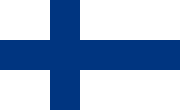 Seinäjoki
Seinäjoki Bourges
Bourges Kristianstad
Kristianstad Roermond
Roermond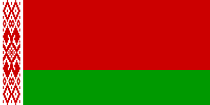 Lida
Lida Fuzhou
Fuzhou
Citations and notes
References
- Dornberger, Walter, Peenemuende, Moewig, Berlin, 1985
Further reading (in Polish)
- collective work, Z dziejów Koszalina, Biblioteka Słupska, tom 7, Wydawnictwo Poznańskie i Polskie Towarzystwo Historyczne, Poznań-Słupsk 1960
- (ed.) A.Lesiński, B.Drewniak, Dzieje Koszalina, Wydawnictwo Poznańskie, Poznań 1967
- Tadeusz Gasztołd, Adam Muszyński, Hieronim Rybicki, Koszalin. Zarys dziejów, Wydawnictwo Poznańskie, Poznań 1974
External links
- Official City Authorities site
- Technical University of Koszalin
- ChefMoz Dining Guide
- Unoffical Forum of Koszalin's Community
Media
- Głos Pomorza, regional daily newspaper
- Głos Koszaliński, regional daily newspaper
- Radio Koszalin, regional radio station
- Radio Północ, regional radio station
- Telewizja Polska Szczecin, regional TV station
- TV MAX, regional TV station
|
||||||||||
|
|||||||
